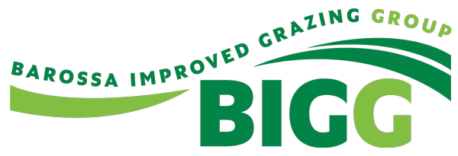Forty-five farmers from across the Barossa, Mid North and Adelaide Hills attended the Barossa Improved Grazing Group (BIGG) Containment Ewe Tour on Wednesday 4th March at various locations around the Barossa Valley.
The event showcased how local producers in this area have set up containment ewe areas, as well as provided informative sessions on containment nutrition, condition scoring ewes and soil ground cover assessments.
Supported by Meat & Livestock Australia (MLA) as part of the containment ewe Producer Demonstration Site Project, as well as the South Australian Murray-Darling Basin Natural Resources Management Board, the event was an excellent opportunity for attendees to visit four different locations in an interactive and educational experience.
Deb Scammell, Talking Livestock Consultant who facilitated the event said the day was a great way to highlight some of the advantages and benefits of containment ewe management on location.
“We visited four different landowners over the course of the day, where we were able to see firsthand the benefits of containment ewe management,” she said. “The take home messages from the demonstration sites were that containing ewes reduces overgrazing, soil erosion and wind erosion, and allowed pregnant ewes to be fed a more efficient ration as they weren’t wasting energy walking around a dry paddock.”
Presenters and farmers spoke on different topics, including nutrition, effective management of ewes in containment and land management. Brian Hughes from PIRSA also spoke of the importance of soil ground cover in the paddock to prevent erosion and reduced growth when there was a break.
William Hurn from Angaston spoke of better lambing percentages and control over nutrition from managing ewes in containment.
“I have found lambing percentages have improved as a result of using containment and we now have better management of rations due to mob segregation,” he said. “Containment also provides an ideal quarantine opportunity where required.”
Georgie Keynes and Toby Rosenzweig from Keyneton currently manage 2,500 ewes in confinement. For them, ground cover is key.
“We aim to maintain (at all times if possible) around 1t/ha of ground cover as reserve for turning out stock prior to lambing,” Georgie said. “Barley is the main grain fed so we make sure we include salt and lime in their ration.”
Bruce and Paul Schutz from Point Pass currently run 1860 merino ewes and 400 wethers.
“We use a feed mixer for mixing a high roughage and barley mixed ration and this is put out into our own design feed bins in containment,” Paul said. “We have the option to move stock to different regions for finishing, so this is an advantage in maintaining balance in our overall faming enterprise.”
“We recommend using bio-start(ruminant) and nutri-mol to condition guts as an induction step to moving stock out of containment,” he said.
Kym Mosey from Bagot Well was the final producer the attendees visited on the day. He said feeding cereal hay in containment pens and then letting ewes out to consume grain in a separate pen has been the easiest way for him to feed large numbers of ewes.
“We have found proximity to feed source and yards was important when deciding where to put pens,” he said. “It was handy to have some other small paddocks with shelter to put sheep into if weather turns. We also have protected trees so that they continue to provide shade in pens.”
The BIGG Containment Ewe Tour was one of the first events of the project supported by MLA. This tour was also supported by the South Australian Murray-Darling Basin Natural Resources Management Board through funding from the Australian Government’s National Landcare Program and NRM levies. More events, activities and communication will be initiated in the next two years as part of the project.
More Information:
Deb Scammell
Consultant
Mob: 0407 790 622
Email: deb@talkinglivestock.com.au
